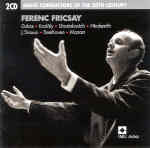Ferenc Fricsay’s star shone briefly–for a decade-and-a-half–after World War II, when he scored successes in Berlin and Salzburg and recorded for DG. However, this entry in EMI’s Great Conductors of the 20th Century series is made up of live concert broadcasts between 1950 and 1961, all but one featuring the orchestra with which he was most closely identified, the RIAS (Radio in the American Sector) Symphony Orchestra Berlin, later renamed the Radio Symphony Orchestra Berlin. It would be an understatement to call the contents of this set variable: the second disc is pretty much a washout, the first includes more of interest though nothing to edge out the preferred versions of these pieces. Since a representative Fricsay set would best be drawn from his DG studio recordings (unless more compelling concert recordings than these are available), the appeal of this one is pretty much limited to Fricsay fans.
To get the worst out of the way, the second disc of the set begins with 1961 concert readings of Beethoven’s Leonore Overture No. 3 and the Eroica Symphony, closing with a 1951 Mozart Cosi fan tutte Overture that actually sounds fresher than the Beethoven pieces, whose sound is boxy and afflicted with tubby bass. This is a decidedly unheroic Eroica, ponderous and enervated. At times, such as the beginning of the funeral march, the orchestra sounds as if it’s an effort just to turn pages much less to produce musical sounds. A brief hint of vitality invades the central section of the movement, quickly lapsing into a terminally somnolent state. Movement timings are in Celibidache territory, and even Klemperer in his 1959 Philharmonia recording easily outpaces Fricsay in three movements and comes in at a dead heat in the last. But a slow Eroica doesn’t necessarily mean a dull one: Bernstein’s Sony recording is not much faster than Fricsay’s but he supplies energy and articulation that brings it alive. Klemperer’s granite-like structures were enlivened by forward winds and an uncanny command of rhythm, and even Celi, by some magical alchemy involving texture and phrasing, manages to convince if you’re in the right mood. But this Fricsay performance, I’m afraid, is guilty of the worst sin that can be inflicted on Beethoven: it’s just plain dull.
The first disc is a lot better. It opens with an exciting 1961 Sorcerer’s Apprentice, though without the mystery and demonic, darker edge with which Markevitch (Testament) elevates the work above routine showpiece status. It’s followed by a fine–and finely recorded–1961 Salzburg Festival performance of Kodály’s Dances of Galánta with the Vienna Philharmonic, a performance full of zest and obvious joy in its colors and rhythms. Shostakovich’s Ninth, from 1954, also is worth hearing though the second movement Moderato seems brisker than necessary, and the orchestra lacks the weight and virtuosity to match rival versions. Bernstein (Sony) and Barshai (Brilliant) have the brass players and the interpretive swagger lacking here.
Hindemith’s Symphonic Metamorphoses on Themes by Weber probably is the closest he came to writing a concerto for orchestra–it’s full of virtuosic passages that shine a spotlight on individual sections and players. The 1952 RIAS band acquits itself well enough, though alongside the roughly contemporaneous Kubelik (Mercury) and stereo versions by the likes of Szell, Bernstein, and Ormandy (all Sony), this is an also-ran. In the Turandot movement, for example, scrambled articulation blurs textures that need to be clarified. The mono sound, while acceptable for its time, doesn’t have the necessary transparency, and the exciting percussion effects don’t fully register. The Strauss Artist’s Life waltz that ends the disc is nicely done, with 1950 sound that has more presence than the 1961 Beethoven works. So this first disc will hold interest, but the set as a whole fails to justify the “great” in “Great Conductors”. Too bad; a different selection might have.[6/27/2002]
































